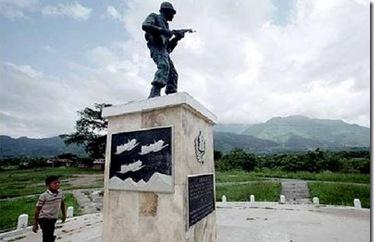The Soccer War of 1969 August 15, 2010
Author: Beach Combing | in : Contemporary , trackbackBeachcombing, po-faced, has to note that most modern historians do not like to refer to the Soccer War of 1969 (La guerra del fútbol) as, well, ‘the Soccer War’. ‘The Hundred Hours War’ or better still ‘the Salvador–Honduras War’ is preferred with a lot of attendant Marxist bilge about poor Salvadoran peasants engaged in class conflict in Honduras.
‘The Salvador-Honduras War’ at least introduces the two combatants.
8 June 1969 neighbours El Salvador and Honduras played each other in a World Cup 1970 qualifying match in the Honduran capital.
The Salvadoran team arrived in Tegucigalpa on Saturday and spent a sleepless night in their hotel. The team could not sleep because it was the target of psychological warfare waged by the Honduran fans. A swarm of people encircled the hotel. The crowd threw stones at the windows and beat sheets of tin and empty barrels with sticks. They set off one set of firecrackers after another. They leaned on the horn of cars parked in front of the hotel. The fans whistled, screamed and sent up hostile chants. This went on all night. The idea was that a sleepy, edgy, exhausted team would be bound to lose. [Kapuściński]
Nothing remarkable here, of course. Such intelligent taunting was a relatively common practice in South American football in the 1960s. But from now on events would deviate from normality.
Honduras beat sleepy El Salvador 1-0, though the goal coming in the very last minute of overtime led to the accusation that El Salvador had been ‘robbed’ (in soccer there is, of course, always the question of how much overtime should be played).
History does not tell us what happened to the referee. But there were fights between fans. There was also despair. An eighteen year old Salvadoran girl, Amelia Bolaños, grabbed, immediately after the match, her father’s pistol and shot herself in the heart.
Sport encourages tragedies. Beachcombing thinks immediately of reports of increased cardiac arrests during World Cup penalty shoot outs.
What was unusual here was how El Salvador reacted. Amelia’s funeral was televised with an army honour guard and the president of El Salvador and his cabinet walking behind the coffin! Amelia – to the horror, doubtless, of those manning suicide telephone lines – had become a national hero.
The second leg of the qualifying match came on 15 June in San Salvador and here an already tense situation got a lot, lot worse. The match was won 3-0 by El Salvador. But the Honduran team had an excuse.
This time it was the Honduran team that spent a sleepless night. The screaming crowd of fans broke all the windows in the hotel and threw rotten eggs, dead rats and stinking rags inside. The players were taken to the match in armoured cars of the First Salvadoran Mechanized Division – which saved them from revenge and bloodshed at the hands of the mob that lined the route, holding up portraits of the national heroine Amelia Bolanios [sic]. [Kapuściński]
There was rioting in which three died and the El Salvadoran police removed ‘weapons’ from El Salvadoran fans as they went into the stadium. The pitch was surrounded by the fierce national guard: that possibly intimidated the Hondurans as much as the booing crowd behind. Then, after the game, Honduran fans were attacked with stones as they returned to their own country: at least two were killed.
The Hondurans, in truth, had got off lightly. As the Honduran coach noted at the time: ‘We’re awfully lucky to have lost’.
But Honduras was furious at the treatment its team had received and Salvadorians in the country were attacked.
Beachcombing was sniffy about the Marxist-style analysis of the underlying tensions behind the war in his opening paragraph. But much tension had, in fact, been caused by hundreds of thousands of Salvadoran campesinos living in Honduras.
These poor immigrants now bore the brunt of Honduran anger, perhaps sixteen thousand being forced over the border as their property was burnt and reports, sadly all too credible, came in of murder and rape.
Tension grew further with rogue planes from both sides causing havoc, strafing and bombing. Then soccer intervened again to help Central America into its first contemporary inter-state war.
26 June a play-off match was played in Mexico City between the two countries that El Salvador won 3-2 after extra time. Amelia Bolaños had killed herself prematurely: though having said that El Salvador was to be humiliated in the World Cup in 1970 conceding a remarkable nine goals in three games.
On the very day of their victory El Salvador severed all diplomatic links with Honduras. And 14July El Salvador’s army and air force moved decisively. From the death of Amelia Bolaños to the ceasefire on 20 July about three thousand would be killed.
Of course, international soccer is bedevilled/enlivened by rivalries between teams. And many of these are, not surprisingly, between neighbours or near neighbours: Argentina vs Brazil, Germany vs the Netherlands, Turkey vs Greece. But this is the one case that Beachcombing has come across where soccer or, indeed, any sport has led to a shooting war. The only other even jokey example that he could come up with was Henry V of England and the Dauphin’s tennis balls.
He is confident that someone will contradict him. DrbeachcombingATyahooDOTcom



